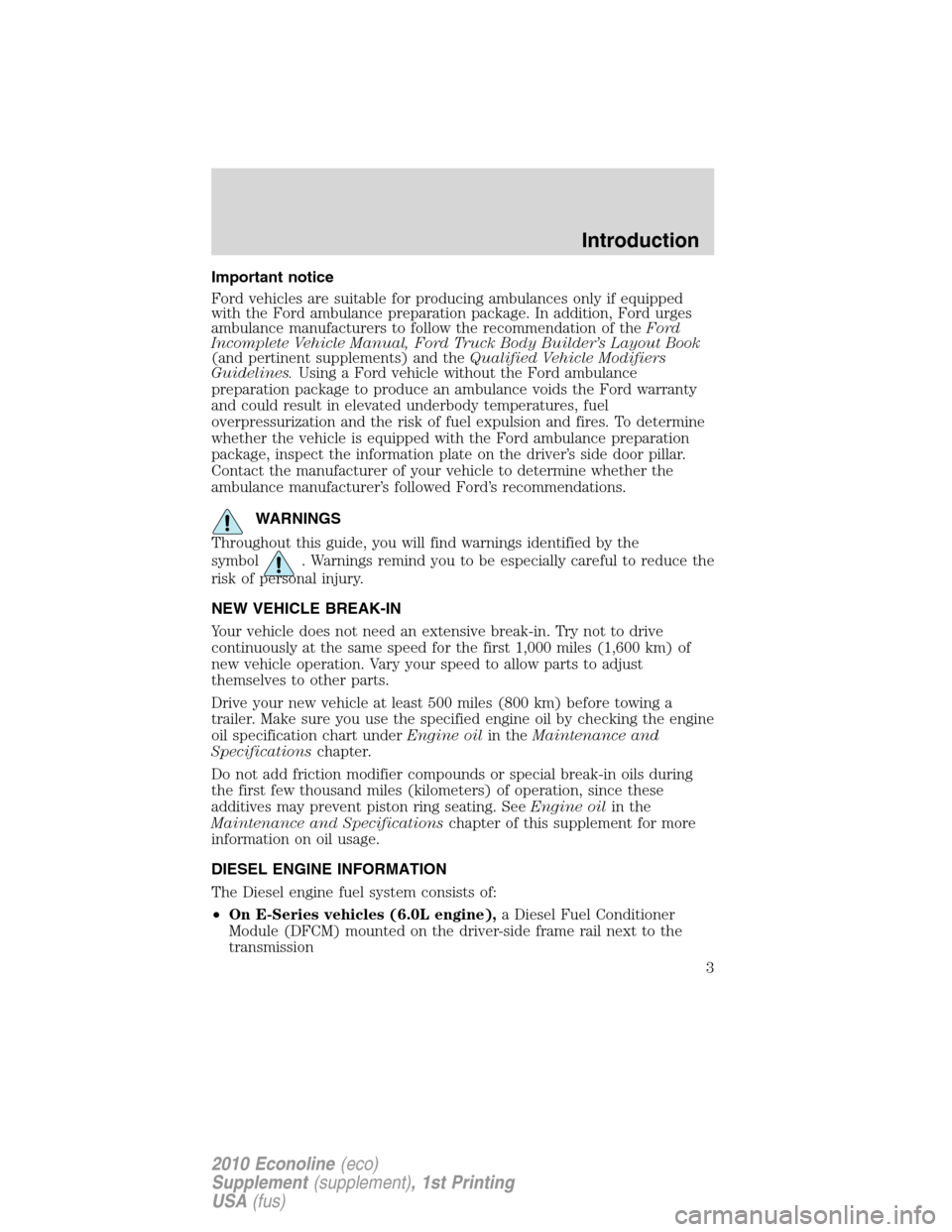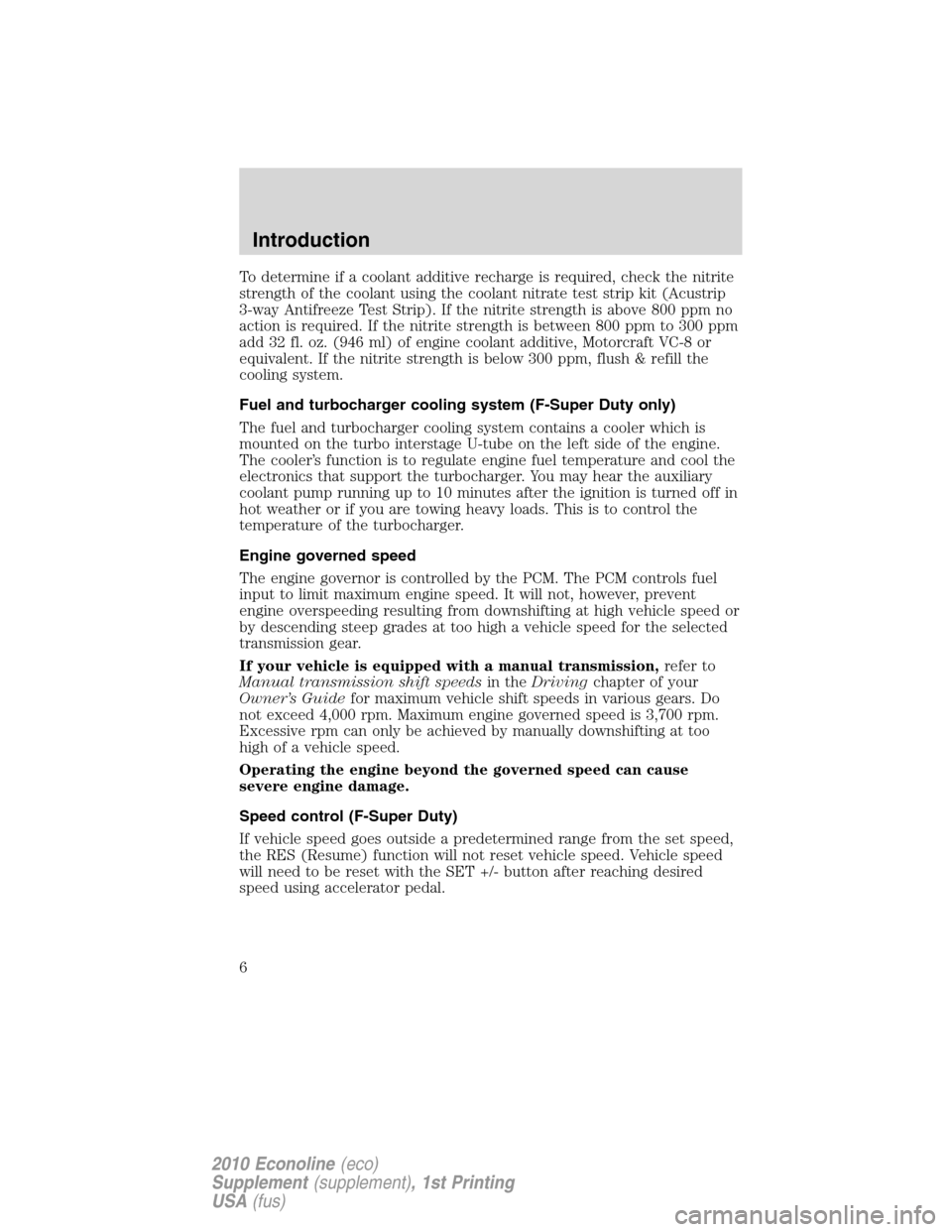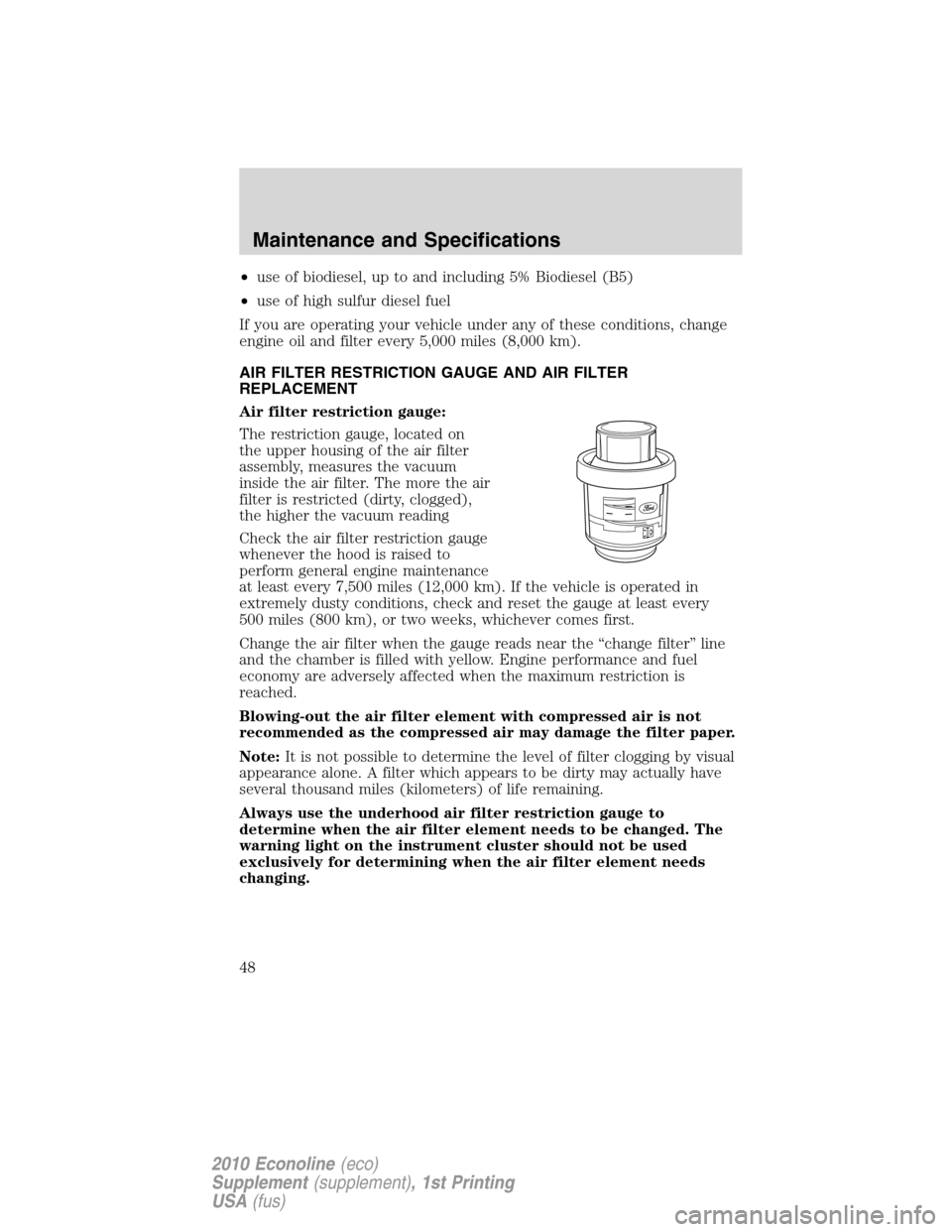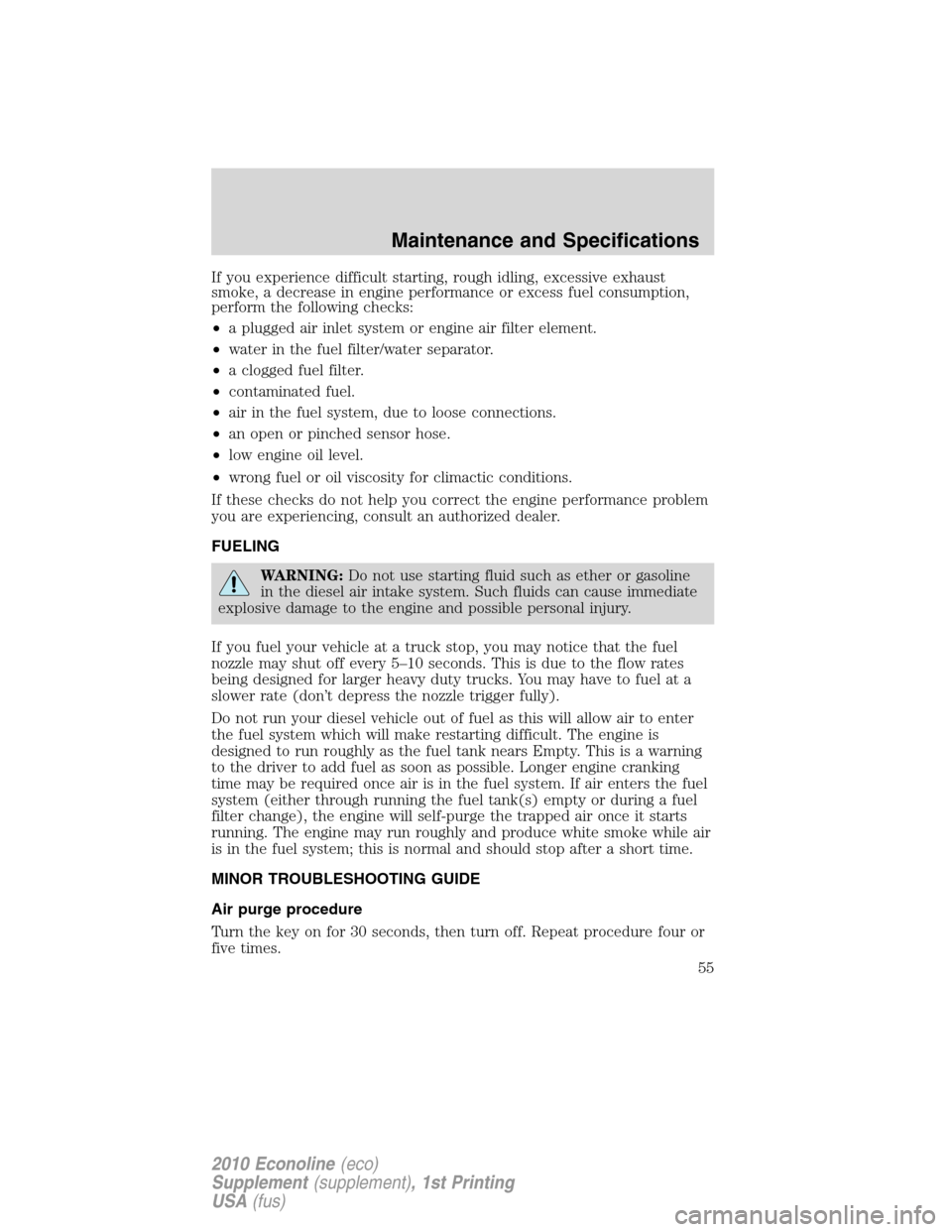2010 FORD SUPER DUTY check engine
[x] Cancel search: check enginePage 3 of 104

Important notice
Ford vehicles are suitable for producing ambulances only if equipped
with the Ford ambulance preparation package. In addition, Ford urges
ambulance manufacturers to follow the recommendation of theFord
Incomplete Vehicle Manual, Ford Truck Body Builder’s Layout Book
(and pertinent supplements) and theQualified Vehicle Modifiers
Guidelines.Using a Ford vehicle without the Ford ambulance
preparation package to produce an ambulance voids the Ford warranty
and could result in elevated underbody temperatures, fuel
overpressurization and the risk of fuel expulsion and fires. To determine
whether the vehicle is equipped with the Ford ambulance preparation
package, inspect the information plate on the driver’s side door pillar.
Contact the manufacturer of your vehicle to determine whether the
ambulance manufacturer’s followed Ford’s recommendations.
WARNINGS
Throughout this guide, you will find warnings identified by the
symbol
. Warnings remind you to be especially careful to reduce the
risk of personal injury.
NEW VEHICLE BREAK-IN
Your vehicle does not need an extensive break-in. Try not to drive
continuously at the same speed for the first 1,000 miles (1,600 km) of
new vehicle operation. Vary your speed to allow parts to adjust
themselves to other parts.
Drive your new vehicle at least 500 miles (800 km) before towing a
trailer. Make sure you use the specified engine oil by checking the engine
oil specification chart underEngine oilin theMaintenance and
Specificationschapter.
Do not add friction modifier compounds or special break-in oils during
the first few thousand miles (kilometers) of operation, since these
additives may prevent piston ring seating. SeeEngine oilin the
Maintenance and Specificationschapter of this supplement for more
information on oil usage.
DIESEL ENGINE INFORMATION
The Diesel engine fuel system consists of:
•On E-Series vehicles (6.0L engine),a Diesel Fuel Conditioner
Module (DFCM) mounted on the driver-side frame rail next to the
transmission
Introduction
3
2010 Econoline(eco)
Supplement(supplement), 1st Printing
USA(fus)
Page 6 of 104

To determine if a coolant additive recharge is required, check the nitrite
strength of the coolant using the coolant nitrate test strip kit (Acustrip
3-way Antifreeze Test Strip). If the nitrite strength is above 800 ppm no
action is required. If the nitrite strength is between 800 ppm to 300 ppm
add 32 fl. oz. (946 ml) of engine coolant additive, Motorcraft VC-8 or
equivalent. If the nitrite strength is below 300 ppm, flush & refill the
cooling system.
Fuel and turbocharger cooling system (F-Super Duty only)
The fuel and turbocharger cooling system contains a cooler which is
mounted on the turbo interstage U-tube on the left side of the engine.
The cooler’s function is to regulate engine fuel temperature and cool the
electronics that support the turbocharger. You may hear the auxiliary
coolant pump running up to 10 minutes after the ignition is turned off in
hot weather or if you are towing heavy loads. This is to control the
temperature of the turbocharger.
Engine governed speed
The engine governor is controlled by the PCM. The PCM controls fuel
input to limit maximum engine speed. It will not, however, prevent
engine overspeeding resulting from downshifting at high vehicle speed or
by descending steep grades at too high a vehicle speed for the selected
transmission gear.
If your vehicle is equipped with a manual transmission,refer to
Manual transmission shift speedsin theDrivingchapter of your
Owner’s Guidefor maximum vehicle shift speeds in various gears. Do
not exceed 4,000 rpm. Maximum engine governed speed is 3,700 rpm.
Excessive rpm can only be achieved by manually downshifting at too
high of a vehicle speed.
Operating the engine beyond the governed speed can cause
severe engine damage.
Speed control (F-Super Duty)
If vehicle speed goes outside a predetermined range from the set speed,
the RES (Resume) function will not reset vehicle speed. Vehicle speed
will need to be reset with the SET +/- button after reaching desired
speed using accelerator pedal.
Introduction
6
2010 Econoline(eco)
Supplement(supplement), 1st Printing
USA(fus)
Page 9 of 104

Glow plug pre-heat indicator:
With the key in the on position,
the
light will illuminate if glow
plug heat is necessary as a starting aid. Wait until the light goes off
before starting. Refer toCold weather startingin theDrivingchapter
of this supplement. After the engine starts, the light should turn on. The
light should always illuminate at least momentarily when the engine is
cold and the ignition is turned to on. If it does not illuminate, the glow
plug system should be checked and repaired promptly to avoid difficulty
in cold starting.
Water in fuel:
F-Super Duty
E-Series
During refueling, it is possible for water-contaminated diesel fuel to be
pumped into your tank. Your vehicle’s fuel system is equipped with a fuel
filter/water separator to remove water from the fuel. The water in fuel
light will illuminate when the FCM/HFCM has a significant quantity of
water in it.
If the light illuminates when the engine is running, stop the vehicle as
soon as safely possible, shut off the engine, then drain the FCM/HFCM.
Refer toDraining the FCM/HFCM and changing the fuel filtersin the
Maintenance and Specificationschapter of this supplement for the
drain procedure. Allowing water to stay in the system could result in
extensive damage to, or failure of, the fuel injection system.
WARNING:Do not drain the water separator while the engine is
running. Fuel may ignite if the separator is drained while the
engine is running or the vehicle is moving.
Instrument Cluster
9
2010 Econoline(eco)
Supplement(supplement), 1st Printing
USA(fus)
Page 14 of 104

COLD WEATHER OPERATION
Changing to a lighter grade engine oil also makes starting easier under
these conditions. Refer toEngine oil specificationsin theMaintenance
and Specificationschapter of this supplement.
Diesel fuel is adjusted seasonally for cold temperatures. Diesel fuel which
has not been properly formulated for the ambient conditions may form
wax crystals which can clog the fuel filter. At temperatures below 20°F
(–7°C), if the engine starts, stalls after a short time, and then will not
restart, the fuel filter(s) may be clogged. For best results in cold
weather, use a diesel fuel which has been formulated for the ambient
conditions. If you have been using biodiesel, you may need to use a fuel
with lower biodiesel content, try another brand, or discontinue using
biodiesel.
Your vehicle is equipped with either an FCM or HFCM which recirculates
fuel from the engine to help prevent fuel filter clogging. Your vehicle is
also equipped with a bypass relief valve, located in the fuel tank pick-up
boot, which provides fuel flow to the engine if the fuel pickup should
become plugged. To allow the bypass valve to function and avoid engine
fuel starvation during cold weather operation of 32°F (0°C) or below, it
is recommended that the fuel level in your tank should not be allowed to
drop below
1�4full. This will help prevent air from entering the fuel
system and stalling the engine.
In cold weather below 32°F (0°C), the engine will slowly increase to a
higher idle speed if left idling in P (Park). As the engine warms-up, the
engine sound level will decrease due to the activation of PCM-controlled
sound reduction features.
If your vehicle is operated in a heavy snow storm or blowing snow
conditions, the engine air induction may become partially clogged with
snow and/or ice. If this occurs, the engine may experience a significant
reduction in power output. At the earliest opportunity, clear all the snow
and/or ice away from inside the air filter assembly. Take the top off the
assembly, leaving the air filter in, and remove any snow or ice.
In order to operate the engine in temperatures of 32°F (0°C) or lower,
read the following instructions:
•Make sure that the batteries are of sufficient size and are fully
charged. Check other electrical components to make sure they are in
optimum condition.
•Use Motorcraft Premium Engine Coolant solution at the concentration
recommended to protect the engine against damage from freezing.
•Try to keep the fuel tank full as much as possible at the end of
operation to prevent condensation in the fuel system.
Driving
14
2010 Econoline(eco)
Supplement(supplement), 1st Printing
USA(fus)
Page 41 of 104

1. Stop the vehicle andshut offthe engine.
WARNING:The vehicle must be stopped with the engine off
when draining the HFCM/FCM. Fuel may ignite if the separator
is drained while the engine is running or vehicle is moving.
2. Locate the HFCM and place an appropriate container under the drain
port (see illustration).
•E-Series
F-Super Duty
3. Rotate drain lever to the outward position. Allow the HFCM/FCM to
drain for approximately 25 seconds or until clean fuel is observed. Rotate
the lever towards the housing until it is firmly seated.
4. Verify that the drain valve is closed and latched, then remove the
container from under the vehicle.
5. Restart the engine and check WATER IN FUEL indicator light; it
should not be illuminated. If it continues to illuminate, have the fuel
system checked and repaired.
Maintenance and Specifications
41
2010 Econoline(eco)
Supplement(supplement), 1st Printing
USA(fus)
Page 44 of 104

2. Remove and discard the old fuel filter element.
3. Carefully clean the mating surfaces.
Installation - both
The engine will not run properly if the fuel filter is not installed
in housing.
1. Install the new fuel filter and cap seal into the fuel filter housing.
Refer toMotorcraft part numberslater in this chapter for the fuel filter
part number.
2. Tighten cap onto fuel filter housing slowly, allowing fuel to soak into
the fuel filter element. Tighten cap until it contacts the housing.
Turn the ignition key to on for 30 seconds, then turn it to off. Do this a
total of six times in a row to purge any trapped air from the fuel system.
Replace the filter bowl O-ring with new seal (included in filter kit) every
time you service the filter.
After filter service, a no start or rough running engine may indicate that
air is entering the system through the filter bowl seal or drain. Make sure
the drain lever is pointing rearward and stowed against the HFCM case.
Using a fuel which has more than average impurities may require
the fuel filter to be replaced more frequently than the service
interval specifies.
ENGINE OIL
Checking the engine oil level
Because it is normal to add some oil between oil changes, check your
engine oil level each time you stop for fuel. To check the engine oil level
consistently and accurately, the following procedure is recommended:
1. Have engine at normal operating temperature (at least into the
NORMAL range on the engine coolant temperature gauge).
2. Park the vehicle on a level surface, then turn off the engine and open
the hood.
3. Allow at least20 minutesafter engine shutdown to ensure that the
oil contained in the upper parts of the engine has returned to the oil
pan.
4. Protecting yourself from engine heat, pull out the dipstick, wipe it
clean and reinsert fully.
Maintenance and Specifications
44
2010 Econoline(eco)
Supplement(supplement), 1st Printing
USA(fus)
Page 48 of 104

•use of biodiesel, up to and including 5% Biodiesel (B5)
•use of high sulfur diesel fuel
If you are operating your vehicle under any of these conditions, change
engine oil and filter every 5,000 miles (8,000 km).
AIR FILTER RESTRICTION GAUGE AND AIR FILTER
REPLACEMENT
Air filter restriction gauge:
The restriction gauge, located on
the upper housing of the air filter
assembly, measures the vacuum
inside the air filter. The more the air
filter is restricted (dirty, clogged),
the higher the vacuum reading
Check the air filter restriction gauge
whenever the hood is raised to
perform general engine maintenance
at least every 7,500 miles (12,000 km). If the vehicle is operated in
extremely dusty conditions, check and reset the gauge at least every
500 miles (800 km), or two weeks, whichever comes first.
Change the air filter when the gauge reads near the “change filter” line
and the chamber is filled with yellow. Engine performance and fuel
economy are adversely affected when the maximum restriction is
reached.
Blowing-out the air filter element with compressed air is not
recommended as the compressed air may damage the filter paper.
Note:It is not possible to determine the level of filter clogging by visual
appearance alone. A filter which appears to be dirty may actually have
several thousand miles (kilometers) of life remaining.
Always use the underhood air filter restriction gauge to
determine when the air filter element needs to be changed. The
warning light on the instrument cluster should not be used
exclusively for determining when the air filter element needs
changing.
Maintenance and Specifications
48
2010 Econoline(eco)
Supplement(supplement), 1st Printing
USA(fus)
Page 55 of 104

If you experience difficult starting, rough idling, excessive exhaust
smoke, a decrease in engine performance or excess fuel consumption,
perform the following checks:
•a plugged air inlet system or engine air filter element.
•water in the fuel filter/water separator.
•a clogged fuel filter.
•contaminated fuel.
•air in the fuel system, due to loose connections.
•an open or pinched sensor hose.
•low engine oil level.
•wrong fuel or oil viscosity for climactic conditions.
If these checks do not help you correct the engine performance problem
you are experiencing, consult an authorized dealer.
FUELING
WARNING:Do not use starting fluid such as ether or gasoline
in the diesel air intake system. Such fluids can cause immediate
explosive damage to the engine and possible personal injury.
If you fuel your vehicle at a truck stop, you may notice that the fuel
nozzle may shut off every 5–10 seconds. This is due to the flow rates
being designed for larger heavy duty trucks. You may have to fuel at a
slower rate (don’t depress the nozzle trigger fully).
Do not run your diesel vehicle out of fuel as this will allow air to enter
the fuel system which will make restarting difficult. The engine is
designed to run roughly as the fuel tank nears Empty. This is a warning
to the driver to add fuel as soon as possible. Longer engine cranking
time may be required once air is in the fuel system. If air enters the fuel
system (either through running the fuel tank(s) empty or during a fuel
filter change), the engine will self-purge the trapped air once it starts
running. The engine may run roughly and produce white smoke while air
is in the fuel system; this is normal and should stop after a short time.
MINOR TROUBLESHOOTING GUIDE
Air purge procedure
Turn the key on for 30 seconds, then turn off. Repeat procedure four or
five times.
Maintenance and Specifications
55
2010 Econoline(eco)
Supplement(supplement), 1st Printing
USA(fus)